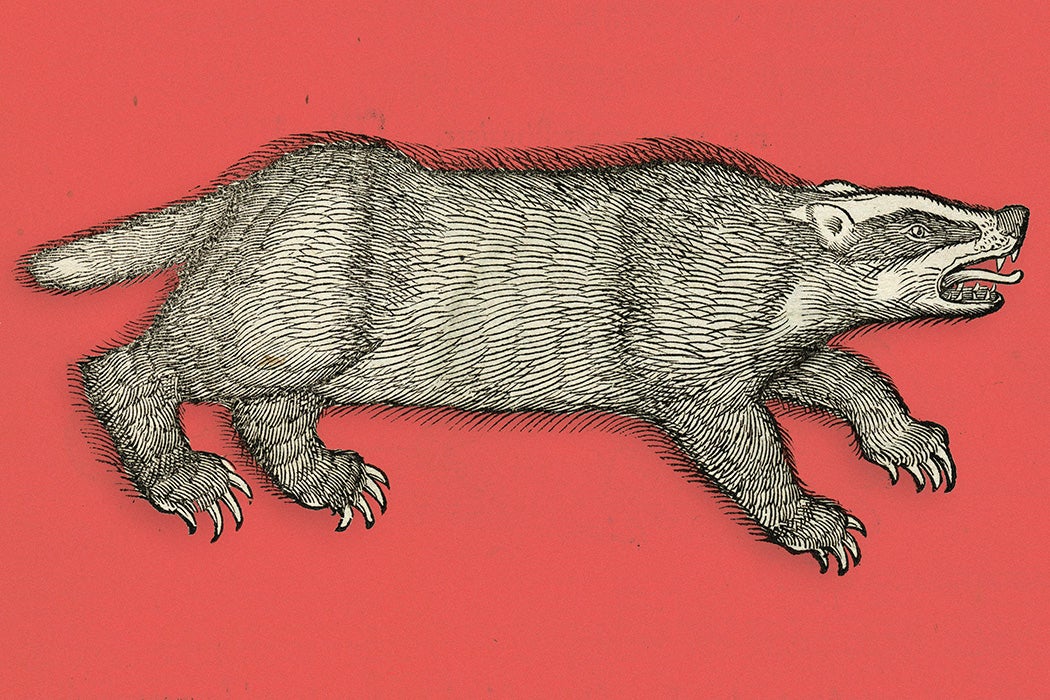National Badger Day is celebrated annually on October 6th. Though the holiday originated in the United Kingdom, the celebration has spread to the United States and elsewhere. The name “badger” refers to the markings, or badge, on the animal’s furred, somewhat fierce, face. (NB, in the United States, Wisconsin is known as the “Badger State,” having acquired the nickname not because of animals, but miners burrowing underground).
Badgers have culturally significant identities around the world, and they’re represented in art from Japan to the UK to the Native American Southwest.
In Japanese folklore, the badger, or tanuki, is a shape-shifting trickster.
“A raccoon-faced creature in its natural form,” Violet H. Harada explains, the badger
could assume numerous shapes. Sometimes it appeared as a one-eyed hag; at other times, it transformed itself into a beautiful young woman. Another favorite shape was that of a black-garbed Buddhist priest…. The tanuki could also fly as a dazzling comet or change itself into a fence post, stone or tree.
A badger’s magical activities could be alternately useful or threatening.
“Possessing extraordinary powers, the badger could predict deaths and see into the future, as well as know of a man’s former existences,” Harada writes. These powers played out in different ways, as the badger played the role of “vengeful transformer, grateful friend and roguish prankster,” depending on the story.
The Japanese badger may have been viewed as powerful and clever, possibly even heroic, but in the folkloric traditions of the Ioway (Bah-Kho-Je) people, it was a victim, not a boss. According to a myth collected by Manyi’hu (possibly Ma-ni-han, known as Robert Small in English), Badger used his supernatural powers to build a hunting trap that couldn’t fail. Because of this hunting success, he was harassed and exploited by Grizzly, who demanded that Badger give all his captures to him.
“Every morning [Grizzly] would force Badger to go out and visit his trap, kill whatever he found in it, butcher it, and then he would take it all, even the blood, leaving Badger only the refuse to support himself and his family,” writes Alanson Skinner, drawing on stories shared by Small. One day, after delivering the kill to Grizzly, Badger sets aside “a mass of coagulated blood” to deal with later. When later arrives, the blood has magically transformed into a (human) baby boy. Somehow Badger and his wife managed to hide the boy from Grizzly. You can probably see where this is going: after years of listening to Grizzly take advantage of his foster parents—and years of practicing with a bow and arrow—the boy killed the bear. Badger’s strength here was not in trickery, but in staying silent as the boy grew.
Weekly Newsletter
In England, the character of Badger in the children’s book The Wind in the Willows takes a different, if somewhat related, approach to the animal. Kenneth Grahame’s story depicts Badger as solitary and somewhat reclusive, but wise. He knows the history of the landscape. His own sett is built among Roman ruins, a decayed cityscape, but he somehow also represents a “changeless rural landscape,” writes John David Moore. Badger becomes a symbol an almost eternal natural cycle, demonstrating that “men and their cities have history, [but] animals and their environments do not.”
Their different roles in multiple cultures makes a little more sense when we realize that badgers, as a group, aren’t very closely related. Taxonomically, they’re what’s called a polyphyletic group. While all badgers are members of the Mustelidae family, which encompasses many small carnivores, a “badger” may belong to one of a range of species and subspecies:
- Honey badger (Mellivora capensis)
- American badger (Taxidea taxus)
- European badger (Meles meles)
- Asian badger (Meles leucurus)
- Japanese badger (Meles anakuma)
- Chinese ferret-badger (Melogale moschata)
- Burmese ferret-badger (Melogale personata)
- Javan ferret-badger (Melogale orientalis)
- Bornean ferret-badger (Melogale everetti)
That animals in different parts of the world developed similar badge markings as camouflage does suggest some degree of convergent evolution. As humans encountered badgers in different places, we assumed they were connected, however distantly. And today they are, as we can celebrate all badgers on Badger Day!







